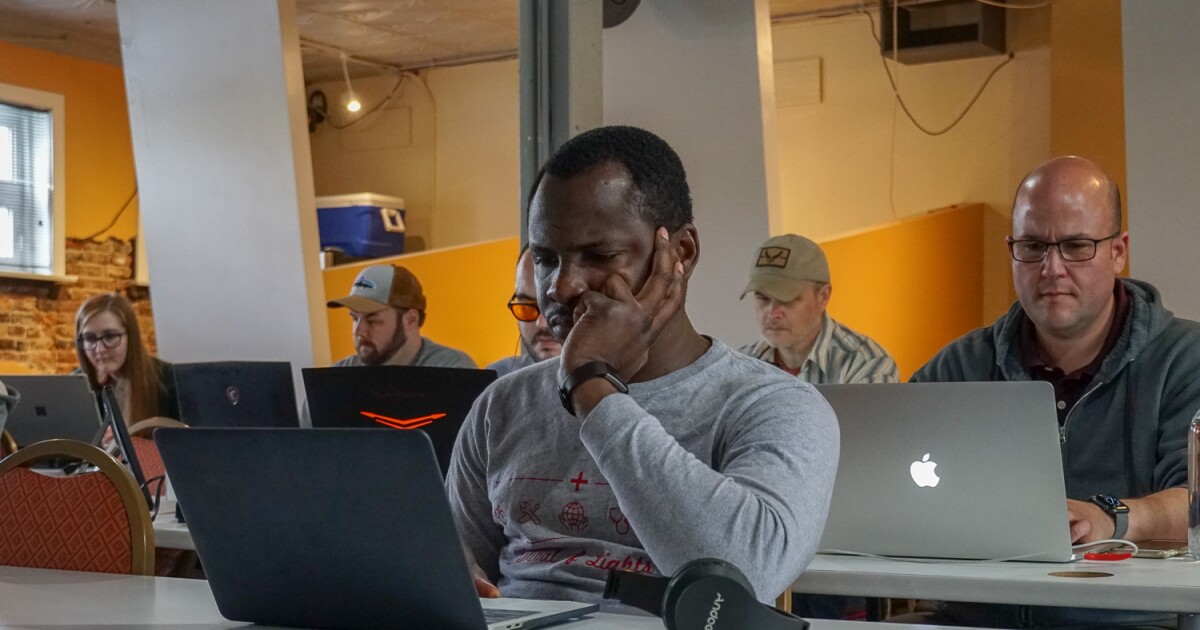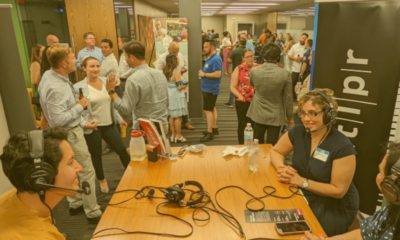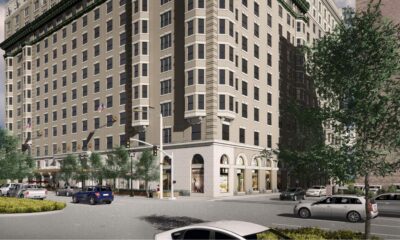Business
Downtown Alton housing project gets a $1 million federal boost
The city of Alton will soon be getting 120 new family housing units in a downtown apartment complex — a project that city leaders and elected officials believe will attract new residents to the area.Dubbed “the Lovejoy” after Elijah Lovejoy, a famed 19th century abolitionist who was assassinated in Alton, the apartment will break ground in 2025 and will be complete by the end of 2026, according to its creators.“We believe this investment in the Lovejoy will go a long way to enhance the quality of life and future prosperity of all for generations to come,” said Kiku Obata, who’s helping design the apartments for local development company AltonWorks.Founded by John Simmons, a prominent local attorney, AltonWorks will own and operate the new apartment complex that will come with a price tag north of $50 million.On Tuesday, city and company leadership celebrated federal funding of nearly $1.06 million to help with construction. The funding, secured by Illinois U.S. Rep. Nikki Budzinski, D-Springfield, came from a U.S. House of Representatives spending bill signed into law by President Joe Biden earlier in March.“When we’re talking about economic development, you can’t separate the need for housing and housing development from making that a reality,” Budzinski said.
Eric Lee
/
St. Louis Public RadioIllinois U.S. Rep. Nikki Budzinski, D-Springfield, third from left, talks with Dennis Highland, lead architect at Kiku Obata & Company on Tuesday at the Wedge Bank Building in Alton.
Eric Lee
/
St. Louis Public RadioShalanda Young, director of the United States Office of Management and Budget, on a building tour organized by AltonWorks on Tuesday at the Wedge Bank Building in Alton.
While Tuesday’s check is just a small portion, it will open the door for future funding, said Joe Weatherly, senior vice president of St. Louis-based design firm McCormack Baron Salazar, who’s running the project.Weatherly estimates they’ve funded roughly 50% of the project so far. The Lovejoy project has pursued mortgage debt and tax credits through Illinois Housing Development Authority.“This money, specifically Representative Budzinski being here, will help us attract other dollars,” Weatherly said.City and AltonWorks leadership see the Lovejoy, and providing affordable housing, as a crucial aspect to revitalizing downtown in a city that’s been bleeding population in recent decades.At its peak, Alton held a population of more than 43,000, according to the 1960 census. Now, that figure stands south of 26,000.“I’m excited to see the change that’s going to take place here in our community,” said Mayor David Goins.This apartment complex, what AltonWorks estimates is the first housing construction project downtown in roughly 40 years, is planned to serve a variety of people from diverse cultural and economic backgrounds, Weatherly said.
Eric Lee
/
St. Louis Public RadioConstruction at the Wedge Bank Building during a tour on Tuesday in Alton.
When completed, the Lovejoy will have a variety of different room layouts. On average, AltonWorks leadership believes rent will range between $800-$1,000 per month depending on the size of the unit, Weatherly said.A mixed-income apartment complex on the north side of East St. Louis, Parsons Place, also received $500,000 for renovations from the same congressional spending, Budzinkski said.“We have to look at it holistically in order to really revitalize some of our communities, and housing investment I think is critical to that,” she said.In all, six Metro East projects received funding from the federal earmarks, totaling about $9.41 million, according to the congresswoman’s office. Others include:East Alton’s water treatment facility will get $5 million to modernize and increase its capacity. An East St. Louis youth workforce development training center will get $1 million to expand its services. Bethalto’s Boys and Girls Club received $1 million to construct a new clubhouse. The city of Wood River will use $850,000 to construct a new detention pond, which will reduce flood risk in a populated part of the city.The Lovejoy is just one of a handful of development projects AltonWorks has in its portfolio. The company has purchased 34 properties downtown and is also working on a food truck park, co-working space, and restaurant, among others.
Business
Chicago Bears pitch $3.2B stadium plan, Pritzker skeptical

The Chicago Bears laid out a $3.2 billion plan for a new domed stadium on Chicago’s lakefront this week, painting pictures of future Super Bowls and other major public events while pinning their hopes on yet-to-be-had conversations with the governor and lawmakers.The Bears — accompanied by Chicago Mayor Brandon Johnson at a Wednesday news conference — proposed a public-private partnership through which the Bears lease the stadium from the Chicago Park District. While the team would put up over $2 billion of the $3.2 billion needed to build the stadium, it’s also seeking $1.5 billion in infrastructure support over several years to realize its vision for a multi-use public park space on Chicago’s lakefront Museum Campus.Chicago Bears president and CEO Kevin Warren said the $2 billion committed by the Bears would be the largest private investment in Chicago history. He also said a new stadium can provide thousands of temporary and long-term jobs for Chicagoans. Warren joined the Bears in early 2023 after previously brokering a deal to bring the Minnesota Vikings a new stadium with a public-private partnership in Minneapolis.“Look around Chicago, I know the mayor is doing all that he can with his leadership to lean in to get economic development going,” Warren said. “We want to be that catalyst.”Despite that major commitment, Bears executives sought to fill an estimated $900 million “gap” through state funding via a bond from the Illinois Sports Facilities Authority, a state agency created in the 1980s to finance new sports stadiums. The team also proposed using the city’s existing hotel tax and restructuring ISFA’s current debt over a 40-year period.While the proposal represents the largest private commitment of any of the recent pushes by professional sports teams for a new stadium yet, it was quickly met with skepticism by Illinois Gov. J.B. Pritzker, who was at a concurrent news conference at Loyola University Chicago.“I’m highly skeptical of the proposal that’s been made and I believe strongly that this is not a high priority for legislators, and certainly not for me when I compare it to all the other things,” Pritzker said.
Dilpreet Raju
/
Capitol News IllinoisChicago Mayor Brandon Johnson and Chicago Bears Chairman George McCaskey pose together after announcing the Bears are seeking to build a new stadium. Johnson said he supports the plan as Illinois Gov. J.B. Pritzker and others raised concern over the use of public dollars.
The governor downplayed the competing news conferences. He’d scheduled his in advance to highlight health insurance reforms that recently cleared the House with his support. The Bears’ announcement was scheduled within the past two days.Part of the proposal includes developing about 15 acres of recreational park space for public use and more stadium vendor businesses owned by women and people of color. Johnson hailed the project for upholding his “criteria for any new development project.”“We require real private investment, real public use and real economic participation for the entire city,” he said.He noted no new taxes would be imposed on Chicago residents and the city can expect “increased tax revenue from this investment, expanded public recreation, stronger economic growth for the entire city of Chicago for generations to come.”Team leaders claimed in their presentation that the stadium would create over 40,000 construction jobs and over 4,000 permanent jobs.The Bears’ presentation noted the organization was seeking about $1.5 billion in three phases of infrastructure investment that could come “at the state level, at the potentially federal level, potentially at the city level,” according to Warren, who gave no specifics.Karen Murphy, the team’s executive vice president of stadium development and chief operating officer, said that includes $325 million in transportation, roadway and utility improvements needed to open the stadium.The remaining funding – at least $1.1 billion – would come over at least five years. That could include $510 million in a second phase of construction for parking upgrades and building surrounding parks and ballfields, followed by $665 million for further attractions and transportation improvements in a third phase. Bears representatives said those estimates are subject to change.Pritzker mentioned “higher priorities for the state” than building a football stadium, including his $4.4 million proposed investment in birth equity centers to create a statewide plan and distribute building grants. And he noted Missouri voters rejected a stadium funding plan for the reigning Super Bowl champion Kansas City Chiefs and for the Kansas City Royals baseball team.“The problem is that the offer that they’ve made just isn’t one that I think the taxpayers are interested in getting engaged in,” Pritzker said of the proposal, later adding, “We’ve seen this fail over and over across the United States.”
Dilpreet Raju
/
Capitol News IllinoisKevin Warren, president and CEO of the Chicago Bears, waits to walk on stage at the Bears’ stadium announcement.
House Speaker Emanuel “Chris” Welch, D-Hillside, who attended the governor’s news conference at Loyola, said he gave Warren a blunt assessment when they recently met privately.“If we were to put this issue on the board for a vote right now, it would fail and it would fail miserably. There is no environment for something like this today,” he said.Senate President Don Harmon, D-Oak Park, also expressed skepticism in a statement.“At first glance, more than $2 billion in private funding is better than zero and a more credible opening offer,” he said. “But there’s an obvious, substantial gap remaining, and I echo the governor’s skepticism.”As for the bonding authority sought by the Bears, Pritzker noted three pro sports teams are seeking money through the ISFA for a new stadium – the Bears, the Chicago White Sox baseball team and the Chicago Red Stars women’s soccer team.“And this is one team that is offering to take all of the tax revenue for their stadium and there apparently is nothing left over for the other two teams,” Pritzker said.While Pritzker had not been briefed on the proposal prior to Wednesday’s news conference, Warren said team representatives “look forward to having some detailed conversations with the state here in the near future.”“Today was the first day that we have been able to publicly roll out our plan,” he said. “It’s very difficult for someone to say they’re against this and we just presented it, so we look forward to having more conversations with individuals in Springfield.”When pressed by media at the Loyola event as to whether there was a “path” for him to support a subsidy plan, Pritzker responded “sure,” but with a caveat.“This has got to be a lot better for taxpayers than what they put forward,” he added. “That’s all I’m saying.”Capitol News Illinois is a nonprofit, nonpartisan news service covering state government. It is distributed to hundreds of newspapers, radio and TV stations statewide. It is funded primarily by the Illinois Press Foundation and the Robert R. McCormick Foundation, along with major contributions from the Illinois Broadcasters Foundation and Southern Illinois Editorial Association.
Business
Boeing buys GKN’s St. Louis plant that makes fighter jet parts

Aerospace company Boeing announced Friday it reached a deal to take over the operations of GKN Aerospace St. Louis, which manufactures parts for Boeing’s F/A-18 and F-15 programs.The agreement among Boeing, GKN and its parent company, Melrose Industries, immediately transitions the latter’s local operations to Boeing. It also includes Boeing hiring the roughly 550-person GKN workforce based in St. Louis.“This is a win-win-win for those employees, Boeing, and the broader St. Louis community,” said Steve Parker, senior vice president and CEO of Boeing Defense, Space and Security, in a statement. “This agreement allows us to not only deliver for our customers, but also gives the highly skilled GKN workforce the opportunity to bring their immense talents to bear in support of the warfighter and the St. Louis defense and aerospace industry.”Local business leaders cheered the move, saying it preserves union jobs and helps the region’s advanced manufacturing sector.“This is a great win for Boeing as well as GKN St. Louis and their 550 employees,” said Greater St. Louis CEO Jason Hall in a statement. “This announcement continues our economic momentum as we look forward to Boeing’s $1.8 billion expansion at the airport.”
Business
Immigrants in St. Louis are making economic contributions

Although the St. Louis region’s population growth has leveled off over the past decade, there has been a modest increase in the area’s immigrant population. Demographers say this increase is a small but helpful contribution to the economic vibrancy of the region.Immigrants living in the metropolitan area make up 4.8% of the total population. According to a recent analysis by the American Immigration Council, immigrant households in the area earned $5.9 billion in total income, paid $1.6 billion in taxes and held $4.3 billion in spending power.Immigrant families play a vital role in the region’s economic success, said Ness Sandoval, professor of demography and sociology at St. Louis University.“Even though our immigrant population is relatively small — compared to Chicago, Miami or New York — the region is still benefiting from the economic power of this group,” he said. “Imagine what that economic power would be like if the immigrant population was three times as large.”New U.S. Census Bureau data shows that the region dropped from being the 21st largest metropolitan area to the 23rd, in the year ending July 1, 2023. Both the Charlotte and Orlando metropolitan areas surpassed St. Louis. Last year, the city lost about 3,250 residents. Also, St. Louis County lost over 3,730 people.Though there is a population loss, many immigrants are finding their way to the area. Today, over 130,000 immigrants call the region home.Sandoval said the region’s immigrant population needs to be over 10% to be consistent with its peers among the top 20 metropolitan regions.“Imagine the types of businesses that would be out there generating jobs contributing back to the economy, businesses that would be supporting nonprofits,” he said. “That’s not here right now, because we don’t have those immigrant businesses, but the ones that are here, we can already see that economic impact.”Nigerian entrepreneur Ola Ayeni moved from Chicago to St. Louis over a decade ago to open Claim Academy, a software engineering and cybersecurity training school. Arch Grants awarded him $50,000 in 2013 to start the company in St. Louis.“St. Louis has been positive for me because I remember when I [first] moved here, I got a lot of support,” Ayeni said.Ayeni was immediately connected to the International Institute and the St. Louis Mosaic Project, as well as other organizations in the area that help immigrants establish themselves in the region.He credits his success to Arch Grants. Today, the academy employs over 20 people, which include immigrants and native born citizens. Ayeni said the company’s finances are consistently in the black and it brings in millions of dollars a year.Although many immigrants own profitable businesses in the city, Sandoval said he is seeing more immigrants open businesses in municipalities along the Interstate 270 corridor.“We are in competition. Many, many cities and regions across the United States want immigrants to move to their region for the reason of the economic activity that they bring to the region,” he said. “Immigrants are more likely to start small businesses compared to American born citizens, and so this is exciting for the business community to see new businesses created.”Ayeni is also contributing to the region’s economy. Besides the software engineering school, he owns a facial company in Chesterfield and is a real estate investor.St. Louis city and county leaders want to increase the population to grow the economy. Although the immigrants’ economic contributions are a small fraction of the region’s total economy, it is a big fraction, compared to its size of population, Sandoval said.To keep attracting immigrants, he said St. Louis has to put forth more efforts that will continue to increase immigrants’ quality of life.“Immigrants who are saying, ‘I don’t want to live in Houston, I want to find another city, I want to find my American dream,’” Sandoval said. “And so that’s where these institutions come into play, because they can now start to advocate and start to promote what the American dream looks like in the St. Louis metropolitan region.”
-

 Entertainment1 year ago
Entertainment1 year agoSt.Louis Man Sounds Just Like Whitley Hewsten, Plans on Performing At The Shayfitz Arena.
-

 Business1 year ago
Business1 year agoWe Live Here Auténtico! | The Hispanic Chamber | Community and Connection Central
-
Board Bills1 year ago
2022-2023 Board Bill 189 — Public Works and Improvement Program at the Airport
-

 Local News1 year ago
Local News1 year agoVIDEO: St. Louis Visitor Has Meltdown on TikTok Over Gunshots
-

 News1 year ago
News1 year agoTed Lasso-inspired pop-up bar now open in St. Louis
-

 Board Bills1 year ago
Board Bills1 year ago2022-2023 Board Bill 165 — Jefferson Arms Community Improvement District
-
Board Bills1 year ago
2022-2023 Board Bill 183 — Amending Ordinance Number 62885 known as the Capital Improvements Sales Tax
-
Board Bills1 year ago
2022-2023 Board Bill 180 — Right to Counsel for Tenants Facing Eviction





